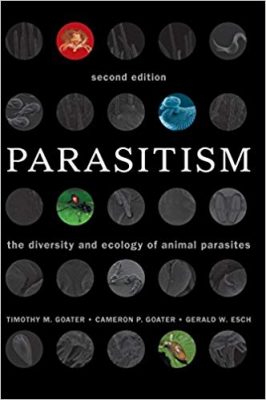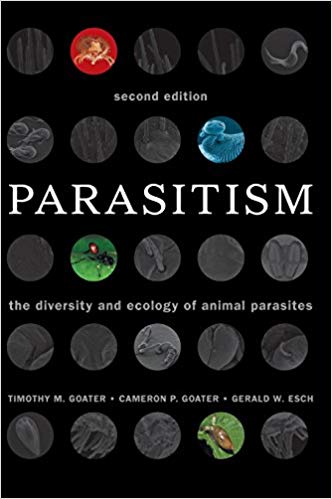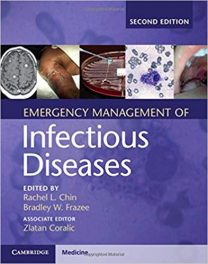 Authors: Timothy M. Goater, Cameron P. Goater, and Gerald W. Esch
Authors: Timothy M. Goater, Cameron P. Goater, and Gerald W. Esch
Publisher: Cambridge University Press – 497 pages
Book Review by: Sonu Chandiram
This second edition released in 2014 stays true to the “philosophical approach” adopted for the first edition published much earlier in 2001, the authors write. They saw a continuing need for an updated text with a dual approach to parasitism that includes diversity and ecology.
This book has been written mainly for senior undergraduate and beginning graduate students who seek “to understand and to appreciate breakthroughs in parasite ecology as well as parallel advances in parasite diversity, functional morphology, life-cycle variation, morphology, and systematics.
This book of almost 500 pages covers a lot of ground as you can see below in our list of chapters that provides you a sort of bird’s eye view of its contents:
- Introduction
- Immunological aspects of parasitism
- Protista: the unicellular eukaryotes
- Microsporida: the intracellular spore-forming fungi
- Myxozoa: the spore-forming cnidarians
- Platyhelminthes: the flatworms
- Acanthocephala: the thorny-headed worms
- Nematoda: the roundworms
- Nematomorpha: the hairworms
- Pentastomida: the tongue worms
- Arthropoda: the joint-legged animals
- Parasite population ecology
- Parasite community ecology
- Parasite biogeography and phylogeography
- Effects of parasites on their hosts: from individuals to ecosystems
- Evolution of host-parasite interactions
- Environmental parasitology: parasites as bioindicators of ecosystem health
Some examples the authors cite, of the relationship between parasite diversity and parasite ecology are covered in the following chapters:
Chapter 3, Protista: the unicellular eukaryotes: provides an understanding of the life-cycle variation, functional morphology, and biodiversity of the apicomplexans
Chapter 6, Platyhelminthes: flatworms: provides a detailed understanding of the variation in life cycles and life histories of the platyhelminthes
Chapter 16, Evolution of host-parasite interactions: provides a real understanding of the evidence in support of the parasite hypothesis for the evolution and maintenance of sexual reproduction in molluscs
This quoted statement in the Preface from the authors provides the crux of the importance of this book versus other works on parasitism:
“Our aim is to provide students with a synthetic understanding of the biodiversity, ecology, and evolution of animal parasites. Thus, throughout most of the text, we unabashedly take a parasite-centered view of the phenomenon of parasitism.
“Yet, we also aim to provide insights on the nature of the host-parasite interaction itself. It is for this reason that following a brief introductory chapter, we provide an overview of vertebrate and invertebrate immunity, and the new discipline of ecological immunology. We turn again and again to the importance of fundamental immunological principles throughout the text.”
Parasitology became an important, if not a necessary subject to study because of the ability of parasites to cause disease. Also, the conditions conducive to disease caused by factors such as war and climate change have been critical aspects of the study of parasites, the author of the Foreword to this book John C. Holmes, points out.
He informs us that the study of parasites and the teaching of their behavior and effects on their human and animal hosts have also been stimulated by zoonotic diseases emerging from altered ecosystems, or carried by arthropod vectors spreading their ranges due to climate change.
The “fascinating life cycles of many parasites and their complex interactions with hosts” has also made this field of study exciting. Holmes writes: “Much of that fascination stemmed from learning how parasites can affect the population dynamics of their hosts, and the behavior of their hosts, or the evolution of the hosts.”
In addition, Holmes writes that the fascination is based on how much parasites can tell us about
The life of their hosts
The diets, travels, and evolution of their hosts
The earth itself – for example. some of the earliest evidence for the drift of the continents was the similarity in parasites of amphibians in Africa and in South America
This book then, provides us a fascinating study of parasites and their effects on their hosts, including their evolution itself.
Editors:
Timothy M. Goater is Professor and former Chair in the Biology Department at Vancouver Island University in British Columbia, Canada. During the past 30 years, he has taught courses in introductory biology, parasitology, ecological parasitology, invertebrate zoology, and entomology. His research interests focus on the population and community ecology of parasites.
Cameron P. Goater is Associate Professor and former Chair in the Department of Biological
Sciences at the University of Lethbridge in Alberta, Canada. His parasitological research roots are in the community ecology of helminthes of waterfowl on the Canadian prairies, and over the past 15 years he has taught courses in introductory biology, invertebrate biology, field biology, and symbiotic interactions. His current research interests are in the experimental ecology of helminth-host interactions.
Gerald W. Esch is Charles M. Allen Professor of Biology at Wake Forest University in North Carolina in the United States where he has taught for 47 years. He is widely regarded as one of the world’s leading parasitologists, and served as Editor of the Journal of Parasitology for 19 years.







